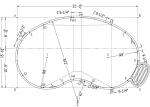Hi,
We are building a kidney shape sport pool. Depth goes from 48" to 64" to 48" starting at 7 feet from each end of the 32"X18" pool with 2 feet in the middle at max depth.
It seems overly difficult to try to determine exactly where the slope and deep part should be without having the pool walls in place (in fact the exact locations are referenced to the locations where the walls meet). I am assuming that we should rough dig before walls go up but do the final dig/grading with the walls in place.
Does this seem reasonable and like best practice or am I way off base?

We are building a kidney shape sport pool. Depth goes from 48" to 64" to 48" starting at 7 feet from each end of the 32"X18" pool with 2 feet in the middle at max depth.
It seems overly difficult to try to determine exactly where the slope and deep part should be without having the pool walls in place (in fact the exact locations are referenced to the locations where the walls meet). I am assuming that we should rough dig before walls go up but do the final dig/grading with the walls in place.
Does this seem reasonable and like best practice or am I way off base?


